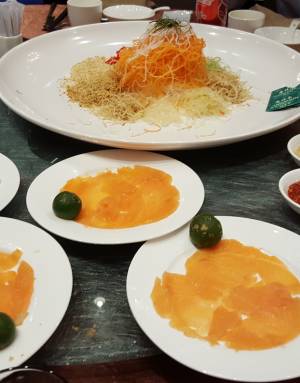Eating Yusheng the Right Way

During the Lunar New Year, there are many different types of delicious foods served. Some are available all year round, but others, such as yusheng, are dishes that you’d not be able to find once the holiday period comes to an end. If you’re in Singapore around the Lunar New Year, take the opportunity to try some yusheng with your friends and family as the experience is like none other.
Even for those extremely familiar with Chinese culture, a tossing up of yusheng at dinner could be a totally different kettle of fish as the practice only exists in Singapore and Malaysia. In fact, this dish was first created by four chefs in Singapore and served during the Lunar New Year in 1964! The dish is especially popular in the Lunar New Year as its name, ingredients and practice are all imbued with cultural significance, and the partaking in this dish is thought to usher in auspicious good fortune for the rest of the year.
Yusheng is part meal, part performance and part activity. For those who aren’t keen to experiment by themselves, one tip would be to go to a good Chinese restaurant to try this dish, as most Chinese restaurant’s servers would be familiar with the procedure and willing to lend a hand. Remember also that this is an additional service, and that it’s considered polite to tip the server with a red packet once the dish is complete and ready for the ingredients to be mixed.
To begin, all the ingredients are laid out in preparation, with a single large dish in the centre that contains a bed of finely sliced vegetables such as radish or carrot. Before adding the other ingredients, the server says a few words as well as some New Year greetings to wish all the participants a good year ahead.
Next, ingredients are added one by one in a prescribed order, each with an accompanying Chinese saying or phrase:
- Raw fish (usually salmon) is added. When the fish is added, the server should say ‘Nian nian you yu’ which is an expression of hope for abundance each year. Yu is a homonym for both abundance and fish.
- Pomelo is added. The corresponding phrase is ‘Daji dali’ which means great fortune and luck. The fruit has always been thought to symbolise prosperity and luck in Chinese culture.
- Pepper and cinnamon powder is added. The server should then say ‘Zhaocai jinbao’ which means to welcome in wealth.
- Oil is poured over the mixture. ‘Yiben wanli’ and ‘caiyuan guangjin’ are again expressions for great wealth, and the wish that returns would be ten thousand times that of the initial investment.
- Shredded carrots are added. ‘Hongyun dangtou’ would then be said. The phrase means that good luck is fast arriving; it is especially appropriate as the first word ‘Hong’ is a homonym for ‘red’—both an auspicious colour and the first word of ‘carrot’ in Chinese.
- Shredded green radish is added. The server should wish the participants ‘Qingchun yongzhu’. The phrase is a wish for eternal youth, and the first word ‘qing’ is once again a homonym, this time meaning ‘green’, the colour of the radish.
- Shredded white radish is added. This dish represents success in business and the corresponding phrases are ‘Bubu gaosheng’ and ‘Fengsheng shuiqi’. The first is a wish for the participants to rise steadily in life, while the latter expresses the hope that one would rise in life as effortlessly and swiftly as the wind and the water.
- Crushed peanuts are added. Like the scattering of the golden brown nuts, the server expresses through the phrase ‘Jinyin mantang” the hope that the coffers of the participants would be filled with bounteous gold and silver.
- Sesame seeds are added. ‘Shengyi xinglong’ is then said, to wish the participants a flourishing of their businesses.
- Plum sauce is drizzled over everything. The simplest of all wishes, ‘tiantian mimi’, is then recited to wish for life to be sweet.
- Crackers are scattered at the end, with a final phrase of ‘piandi huangjin’ that wishes for incredible wealth.
At this conclusion, diners should then proceed to stand and use their chopsticks to mix the ingredients together while enthusiastically throwing the ingredients up in the air. Many believe that the height of the toss would correspond to their fortunes, and as such, don’t be too surprised at the aftermath when vegetables and sauce bestrew the floor!
08 Feb 2017Rayne